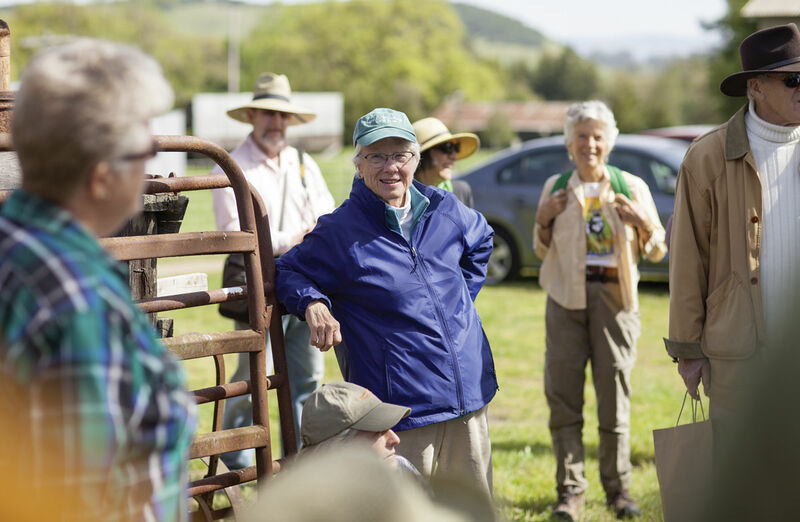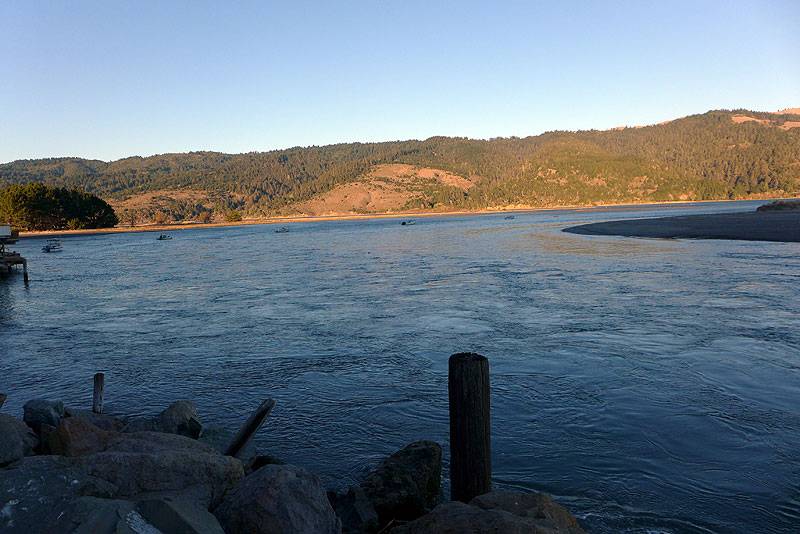Phyllis Faber, Ecologist, Botanist, Activist
Historical Essay
by David Kupfer, January 2023
Phyllis Faber at the start of a wildflower hike on behalf of the Marin Agricultural Land Trust, of which she was a co-founder, 2013.
Photo: Paige Green, via baynature.org
My old dear friend Phyllis Faber passed over the weekend. She was 95, a veteran California environmental activist, writer, editor, publisher, educator, and coastal wetlands scientist Phyllis made countless singular contributions to the Bay Area environmental movement. With the late Ellen Straus, she co-founded the nation’s first agricultural land trust, Marin Agricultural Land Trust (MALT) 43 years ago. She was a leader in the campaign for the California Coastal Commission in 1972 and served on the North Central Regional Commission, including as chair for two years.
Phyllis was born in New York City, .and told me the influence of her father early on and later Joy Lee, taught her that to prevail, science has to fit together with policy in a political world. She graduated with a B.S. in zoology from Mount Holyoke College, and received her M.S. in microbiology at Yale. She first moved to the Bay Area for a few years in the early 1960s, then moved back to stay in 1971, settling in Marin with her husband and three children. She combined duties as a mother, a consulting coastal wetland biologist, a teacher of biology and natural history at the College of Marin, and an environmental advocate. She was also one of the founding instructors at the Environmental Forum of Marin.
Phyllis began her long publishing career in 1982 when she wrote and published Common Wetland Plants of Coastal California. She since worked on numerous books about California flora and ecosystems and served as editor of Fremontia, the journal of the California Native Plant Society, from 1984 to 1999. Until recently, she remained active in publishing as the co-editor of the Natural History series for University of California Press.
Phyllis told me once that having young children at home prevented her from taking a lab job doing what she'd been trained to do, which was unraveling the structure of DNA. So she accepted a job teaching science at a private school in Connecticut. And the teacher she replaced, Joy Lee, made it a point to inform her that we were losing our marshes and needed to protect them. She also made the connection between science and politics. She told me, “Do you know the world is going to fall apart because we’re losing our wetlands? You must pay attention to the wetlands.” It made a huge impression. She became fully engaged in the environmental movement through this issue of the loss of wetlands. So when we moved out to California, I was primed."
Bolinas lagoon looking east towards Audubon Canyon Ranch in the hills, November, 2015.
Photo: Chris Carlsson
Phyllis started teaching with a group of biologists who taught at Audubon Canyon Ranch by Bolinas Lagoon. Because of her concern about losing wetlands, she started working on the campaign to create the Coastal Zone Conservation Act, Proposition 20. There were 10 miles of coastal beachfront that the developers of Sea Ranch on the northern Sonoma coast had blocked from public access. There were huge gravel mines being sited along the coast, and oil companies were gearing up for extensive offshore drilling. Exploitation of the coast was well under way. But there was no regional planning, and decisions were made by local governments that were largely interested in enhancing their tax base through development. After the Coastal Act was passed by the voters, local state senator, Peter Behr, appointed Phyllis to the regional Coastal Commission, a was life-changing for her. "It was incredible," she told me, "to see how legislation can happen and to see what a change that legislation could make in the prospects for the coast. It changed California, and it was a citizen initiative; I’m really proud of the citizens of this state for having passed it."
When I asked her once why environmental consciousness has so flourished here in the Bay Area, she told me "the Bay Area has a rather exceptional population of people who love the environment. It might be expensive to live here but people are willing to pay the price. The educational opportunities and the beauty of the region attract activist types. The affluence means people have money and time to support nonprofit groups and the energy, education, and understanding to direct them, and, the freedom that women have in California, the level of self-confidence, opportunity, and idealism that women have compared to other parts of the country, has really driven the movement. The freedom that women have in California, the level of self-confidence, opportunity, and idealism that women have compared to other parts of the country, has really driven the movement.”
In the late 1970s, West Marin dairy ranchers Ellen and Bill Straus, opened up their ranch to Phyllis to bring out students from Drake and Redwood high schools. Ellen and Phyllis became great friends. At the time, land developers were attracted to West Marin by the creation of the Point Reyes National Seashore and the tremendous population growth in the region. Ranchers, particularly those who were third- and fourth-generation, were reeling from the changes and many were selling their land; there were “For Sale” signs up and down Tomales Bay.
Phyllis told me, "Ellen and I talked about this situation and felt we had to do something. In 1978, we interviewed a number of local ranchers and heard from Boyd Stewart in Olema that land security was what enabled his family to stay in agriculture. He had sold his land to the Point Reyes National Seashore with a long-term lease-back. That’s how his family could count on a future in agriculture. We realized that a land trust might work by taking away the pressure for the rancher to sell his land. We went to the Trust for Public Land, which had experience with land trusts, and they endorsed the idea. Timing is everything. MALT developed at a particular moment when all the right people just happened to be working on related issues. And it turned out that an experimental land trust was an appealing alternative to the Coastal Commission staff’s suggestion to require a higher ratio of land to houses as a way of slowing development. This had been very controversial and the county supervisors were reluctant to impose what seemed unjust to much of the ranching community. So they agreed to let us try a land trust."
43 years later, more than 50 percent of Marin’s ag land has been protected by easements, meaning that development rights have been extinguished in perpetuity. In 1980, it was a brand-new concept; no one had ever done anything like it. But now the idea has been replicated across the nation, there are not hundreds but thousands of land trusts today.
Phyllis was thrilled to be living her final decades in Mill Valley next to the Bothin salt marsh, where the daily tidal cycles and the myriad birds that visit the marsh provided endless pleasure. She loved walking at Stinson Beach, and up on Mount Tamalpais, on the Matt Davis and Nora trails, and to stroll along the Bear Valley Trail at Point Reyes.
When I last spent time with her a month ago over a cup of tea at her Mill Valley home overlooking Richardson Bay's Bothin Marsh, she was reflective and quite happy with her life and longevity. "I've had a great life." she shared. "I couldn't be happier, I remain in good health, and count my blessings every day!" I count mine for having known her as an incredible role model and friend. She is a true under sung Bay Area Heroine. We all all better for her passage through this way.


